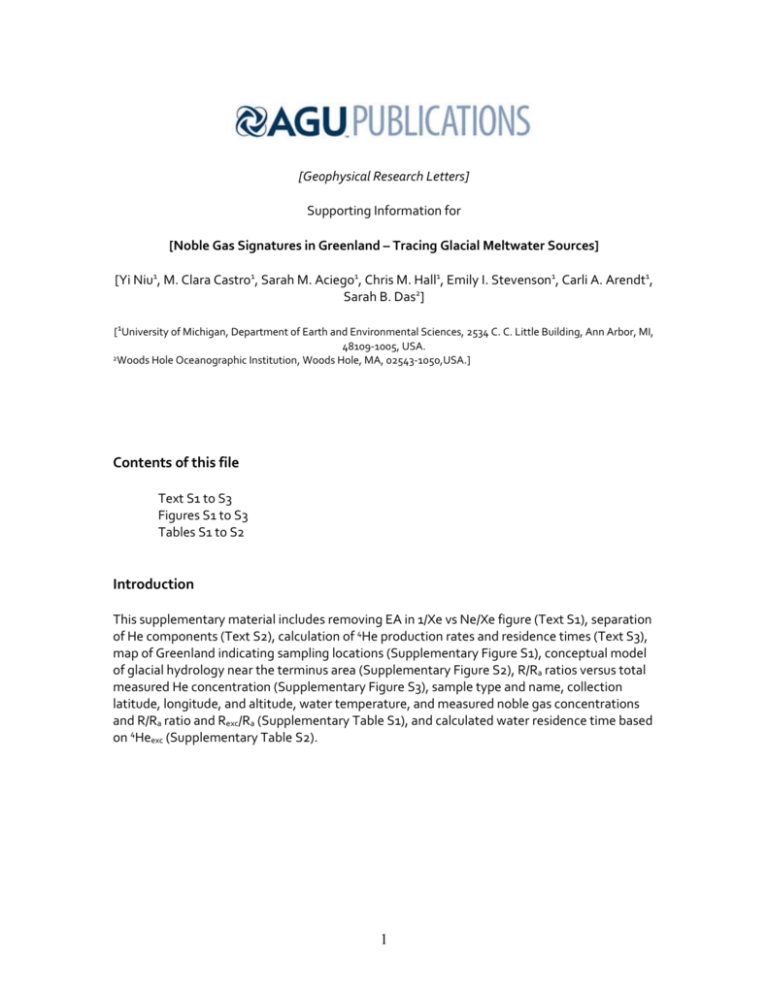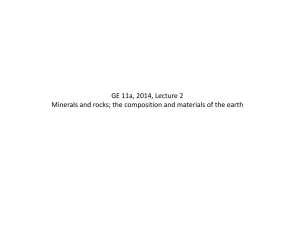grl53644-sup-0001-supplementary
advertisement

[Geophysical Research Letters] Supporting Information for [Noble Gas Signatures in Greenland – Tracing Glacial Meltwater Sources] [Yi Niu1, M. Clara Castro1, Sarah M. Aciego1, Chris M. Hall1, Emily I. Stevenson1, Carli A. Arendt1, Sarah B. Das2] [1University of Michigan, Department of Earth and Environmental Sciences, 2534 C. C. Little Building, Ann Arbor, MI, 48109-1005, USA. 2Woods Hole Oceanographic Institution, Woods Hole, MA, 02543-1050,USA.] Contents of this file Text S1 to S3 Figures S1 to S3 Tables S1 to S2 Introduction This supplementary material includes removing EA in 1/Xe vs Ne/Xe figure (Text S1), separation of He components (Text S2), calculation of 4He production rates and residence times (Text S3), map of Greenland indicating sampling locations (Supplementary Figure S1), conceptual model of glacial hydrology near the terminus area (Supplementary Figure S2), R/Ra ratios versus total measured He concentration (Supplementary Figure S3), sample type and name, collection latitude, longitude, and altitude, water temperature, and measured noble gas concentrations and R/Ra ratio and Rexc/Ra (Supplementary Table S1), and calculated water residence time based on 4Heexc (Supplementary Table S2). 1 Text S1. Removing EA in 1/Xe vs Ne/Xe figure. Any addition of EA to a sample moves it toward the bottom-right following the arrows indicating EA. In order to estimate the higher limit of equilibration temperature, the sample may be moved toward the up-left parallel to the EA arrows by a certain amount to its collection altitude, without knowledge of the exact amount of EA present in the sample. The equilibration altitude is always higher than or equal to the collection altitude; therefore, when a sample is moved to its collection altitude, its maximum equilibration temperature can be estimated. Text S2. Separation of He components. This analysis is typically done by plotting Rnoea/Ra versus 4Heeq/4Henoea [e.g., Castro, 2004], where Rnoea and 4Henoea are the 3He/4He ratios and total measured 4He concentration at collection conditions after removal of EA, and 4Heeq is the ASW 4He concentration under collection conditions (Fig. 4). The EA components are estimated using Ne, Ar, Kr, and Xe concentrations in the NGT model described in Ballentine and Hall [1999] for the four samples with Ne excess and assumed to be 0 for the nine samples with Ne depletion. More details and applications can also be found in Saar et al. [2005]. R/Ra crustal and mantle end-members are assumed to be 0.02 [O'Nions and Oxburgh, 1983] and 8 [Farley and Neroda, 1998], respectively (Fig. 4). Lines with varying contributions of crustal and mantle He as well as tritiogenic 3He are represented. In this graphic, a sample displaying a value of 1 in the horizontal axis points to a component of atmospheric origin in its entirety, while a value approaching 0 points to a solely crustal origin. Increasing values on the left vertical axis denote increasing mantle contributions, while increasing values on the right vertical axis reflect increasing tritiogenic 3He amounts (in tritium units, TU). Samples plotting along a particular line represent varying contributions of these components. Text S3. Calculation of 4He production rates and residence times. 4 He production rates in basement rocks are calculated as follows [Ballentine et al., 1991]: P (4He)rock = 1.207×10-13 [U] + 2.867×10-14 [Th] cm3 STP grock-1 yr-1 where [U] and [Th] represent the U and Th concentrations in average granodiorite and granite formations [Parker, 1967] which are among the most common rocks in our study area [Baadsgaard, 1973; Friend and Nutman, 2005; Dawes, 2009; Klint et al., 2013]. U and Th concentrations, which are higher in felsic granites and granodiorites ([U] = 3.5ppm; [Th] = 18ppm) are used to estimate minimum water ages and those in high calcium granites, with lower U and Th concentrations ([U] = 3ppm; [Th] = 17ppm), are used to estimate maximum water ages. 4He accumulation rates in water, P (4He)H2O, were subsequently estimated according to: P (4He)H2O = P (4He)rock * ρr * Λ * (1-ω)/ω cm3 STP cmH2O-3 yr-1 where ρr is the mass density of the rock, assumed to be 2.7g/cm3; ω is the porosity of the basement rock, assumed to be 2.5%, the average value of unweathered, dense crystalline rocks [Domenico and Schwartz, 2008]. Λ, which is the transfer efficiency of 4He from the rock to the water is assumed to be 1 [Torgersen et al., 1989]. 2 Using 4He production rates, residence times can be estimated based on 4Heexc. It is plausible to assume that both groundwater and surface water have comparable ASW values. This assumption should be applicable in the terminus area of glaciers where temperature and altitude at the surface are not very different from those on the bottom. The build up of radiogenic 4He in the groundwater component is used to differentiate groundwater from surface water and to calculate the respective fractions. The calculated residence times will correspond to the mixing water as a whole, i.e., surface and groundwater/basal water. 3 Figure S1. Map of Greenland [Modified from Bamber, 2001]; sampling locations and type of samples collected are indicated. 4 Figure S2. Conceptual model of glacial hydrology near the terminus area. 5 1.15 Terminus Surface River Atmospheric 1.1 KL-R2 1.05 1.0 0.95 0.9 0.85 NR-S1 KU-T2 KL-T1 NU-S1 KL-S1 KU-T1 0.8 IL-T1 NU-T2 R/Ra 0.75 0.7 0.65 KL-T2 KL-R1 0.6 0.55 0.5 0.45 NU-T1 0.4 0.35 0.3 NR-T1 0.25 0.2 0.4 0.5 0.6 0.7 0.8 0.9 1 2 3 -7 4 3 Measured Total He Concentration (10 cm STP/g) Figure S3. Measured R/Ra values versus total He concentrations, indicating negative correlation between R/Ra values and He concentrations. 6 Table S1. Sampling locations, sample type, measured water temperatures and noble gas concentrations, R/Ra, and Rexc/Ra valuesa. Sample type and number Location Longitude (West) Latitude (North) Elevation (m) Water Temperature (°C) He 10-8 cm3 STP g-1 Ne 10-7 cm3 STP g-1 Ar 10-4 cm3 STP g-1 Kr 10-8 cm3 STP g-1 Xe 10-9 cm3 STP g-1 R/Ra (±1σ) Rexc/Ra (±1σ) NR-T1 Narsarsuaq 45°19.765' 61°12.466' 25 1.1 33.80 2.53 5.19 11.56 15.90 0.25 (0.01) 0.09 (0.02) IL-T1 Ilulissat 50°22.957' 68°53.851' 10 0.0 6.42 1.74 4.31 10.05 14.82 0.78 (0.02) 0.05 (0.08) KL-T1 Kangerlussuaq 50°03.549' 67°08.144' 417 0.0 6.62 2.25 4.78 11.50 17.40 0.91 (0.02) 0.63 (0.31) KL-T2 Kangerlussuaq 50°03.527' 67°08.147' 406 0.1 7.09 1.41 3.28 7.18 9.06 0.67 (0.01) 0.03 (0.05) NU-T1 Nuuk 49°57.123' 64°06.167' 176 0.0 21.09 2.75 5.76 12.39 17.21 0.41 (0.01) 0.15 (0.05) NU-T2 Nuuk 49°57.123' 64°06.167' 176 0.0 6.73 1.91 4.75 11.42 16.88 0.75 (0.01) 0.12 (0.06) KU-T1 Kulusuk 38°27.524' 65°42.597' 0 0.3 6.23 1.95 5.19 12.48 19.43 0.83 (0.02) 0.21 (0.10) KU-T2 Kulusuk 38°27.524' 65°42.597' 0 0.3 5.79 1.91 4.64 10.84 15.81 0.90 (0.02) 0.36 (0.16) NR-S1 Narsarsuaq 45°18.243' 61°13.347' 71 0.1 6.68 2.25 3.81 8.60 11.99 0.92 (0.01) 0.41 (0.16) KL-S1 Kangerlussuaq 50°02.154' 67°08.961' 513 0.0 5.41 1.90 4.68 11.32 17.53 0.86 (0.02) 0.05 (0.14) NU-S1 Nuuk 49°18.269' 64°00.367' 1221 0.2 5.59 1.74 4.19 9.87 14.49 0.88 (0.02) 0.51 (0.09) KL-R1 Kangerlussuaq 50°56.843' 66°57.958' 122 2.8 8.03 1.87 4.66 10.73 16.48 0.67 (0.02) 0.17 (0.05) KL-R2 Kangerlussuaq 50°16.599' 67°04.634' 248 2.6 5.32 1.90 4.79 11.10 17.07 1.06 (0.06) 1.54 (0.60) Terminus Surface River a Measurement errors of noble gas concentrations are 1.5%, 1.3%, 1.3%, 1.5%, and 2.2% for He, Ne, Ar, Kr, and Xe, respectively. Helium isotope ratios, R = 3He / 4He, are normalized by the atmospheric value of Ra = 1.384 × 10-6. b 1 Table S2. Water residence times calculated based on 4Heexc (cf. Text S1). Sample Type and Number Location 4 Heexc (10-8 cm3 STP g-1) +/- Minimum Age (years) +/- Maximum Age (years) +/- Average Ages (years) +/- Ternimus NR-T1 IL-T1 KL-T1 KL-T2 NU-T1 NU-T2 KU-T1 KU-T2 Narsarsuaq Ilulissat Kangerlussuaq Kangerlussuaq Nuuk Nuuk Kulusuk Kulusuk 27.8 1.52 1.54 2.43 14.6 1.92 1.34 0.89 0.73 0.01 0.43 0.11 0.80 0.10 0.09 0.09 2800 150 160 250 1500 190 140 90 100 10 40 10 100 10 10 10 4400 240 240 380 2300 300 210 140 100 20 70 20 100 20 10 10 3600 200 200 310 1900 250 170 110 100 10 40 10 100 10 10 10 Surface NR-S1 KL-S1 NU-S1 Narsarsuaq Kangerlussuaq Nuuk 0.94 0.80 1.36 0.13 0.08 0.08 95 80 140 14 8 10 150 120 210 20 10 10 120 100 180 10 10 10 River KL-R1 Kangerlussuaq 3.28 0.12 330 10 510 20 420 10 2 References Baadsgaard, H. (1973). U-Th-Pb dates on zircons from the early Precambrian Amîtsoq gneisses, Godthaab district, West Greenland. Earth and Planetary Science Letters, 19(1), 22-28. Ballentine, C. J., and Hall, C. M. (1999). Determining paleotemperature and other variables by using an error-weighted, nonlinear inversion of noble gas concentrations in water. Geochimica et Cosmochimica Acta, 63(16), 2315-2336. Ballentine, C. J., O'nions, R. K., Oxburgh, E. R., Horvath, F., and Deak, J. (1991). Rare gas constraints on hydrocarbon accumulation, crustal degassing and groundwater flow in the Pannonian Basin. Earth and Planetary Science Letters, 105(1), 229-246. Bamber, J. (2001). Greenland 5 km DEM, Ice Thickness, and Bedrock Elevation Grids. Boulder, Colorado USA: NASA National Snow and Ice Data Center Distributed Active Archive Center. Castro, M. C. (2004). Helium sources in passive margin aquifers—new evidence for a significant mantle 3 He source in aquifers with unexpectedly low in situ 3He/4He production. Earth and Planetary Science Letters, 222(3), 897-913. Dawes, P. R. (2009). The bedrock geology under the Inland Ice: the next major challenge for Greenland mapping. Geological Survey of Denmark and Greenland Bulletin, 17, 57-60. Domenico, P. A., and Schwartz, F. W. (1998). Physical and chemical hydrogeology (Vol. 44). New York: Wiley. Farley, K. A., and Neroda, E. (1998). Noble gases in the earth's mantle. Annual Review of Earth and Planetary Sciences, 26(1), 189-218. Friend, C. R., and Nutman, A. P. (2005). New pieces to the Archaean terrane jigsaw puzzle in the Nuuk region, southern West Greenland: steps in transforming a simple insight into a complex regional tectonothermal model. Journal of the Geological Society, 162(1), 147-162. Klint, K. E. S., Engström, J., Parmenter, A., Ruskeeniemi, T., Liljedahl, C., and Lehtinen, A. (2013) Lineament mapping and geological history of the Kangerlussuaq region, southern West Greenland. Geological Survey of Denmark and Greenland Bulletin 28, 57–60. O'Nions, R. K., and Oxburgh, E. R. (1983). Heat and helium in the earth. Nature, 306(5942), 429431. Saar, M. O., Castro, M. C., Hall, C. M., Manga, M., and Rose, T. P. (2005). Quantifying magmatic, crustal, and atmospheric helium contributions to volcanic aquifers using all stable noble gases: Implications for magmatism and groundwater flow. Geochemistry, Geophysics, Geosystems, 6(3). Torgersen, T., Kennedy, B. M., Hiyagon, H., Chiou, K. Y., Reynolds, J. H., and Clarke, W. B. (1989). Argon accumulation and the crustal degassing flux of 40 Ar in the Great Artesian Basin, Australia. Earth and planetary science letters, 92(1), 43-56. 1






